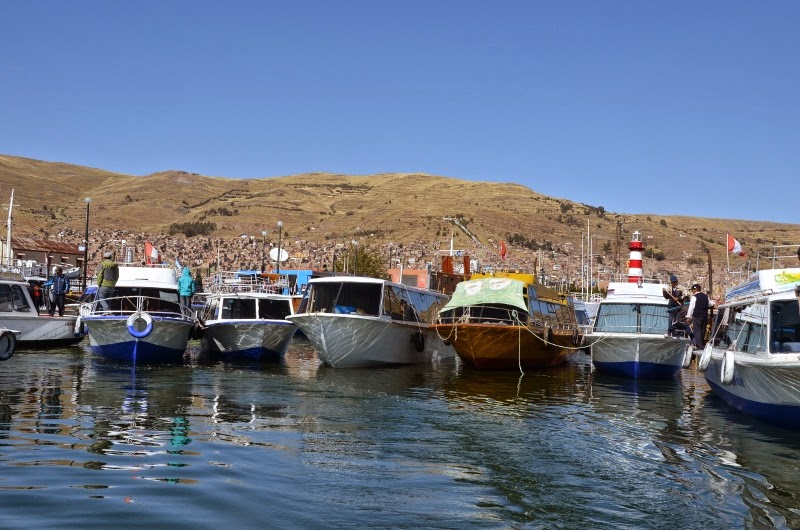Lago
Titicaca with its Islas Flotantes (Floating Islands)
Islas de los
Uros y las Isla Taquile
Friday, Saturday, Sunday, Sept 19, 20 & 21
A Two-night trip to Puno and Lago (Lake) Titicaca—Islas
de los Uros y Isla Taquile
.jpg) |
| Our international group from the US, Columbia, and Mexico |
We
left for our trip to Puno and Lake Titicaca Friday afternoon around 4 pm, so we
were able to see Misti, Chachani, and snow-covered Ampato as we left Arequipa
and ascended. Profe had advised us to take cold-weather gear along since we
would be boating and hiking above 12,500 feet. In addition, we ascended above
15,000 feet with the bus. Saturday morning was sunny and a few of us wore
t-shirts for at least part of the day. This year we arrived here with 24 students from the US, Columbia, and
Mexico.
.jpg) |
| On the boat above and below |
|
.jpg) |
| Numerous boats waiting for passengers |
.jpg) |
| A family trying to avoid us |
.jpg) |
| A local fisherman |
.jpg) |
| The channel through which we pass to get to the main body of Lago Titicaca |
.jpg) |
| Our international group above and below |
.jpg) |
| Love the sun. |
.jpg) |
| Upper deck |
.jpg) |
| There was a ring around the sun, but I forget its proper name. |
We left the hotel a bit after 8 am to
hop on board a boat to travel on Lago Titicaca. It took at least two hours to
arrive at Islas Flotantes (Floating islands) inhabited by the Uros people. The
man-made islands float on reeds approximately 7 km east of the Puno harbor. I
had my GPS and noted that the fastest our boat went was 9.5 mph. But we were on
the lake for 9 hours covering about 75 km (approx. 40 miles) roundtrip. I
remember reading about this lake and these islands decades ago in National Geographic, but I never
dreamed about coming here since for the past 40 years (1972-2012) my life was
devoted to archaeological work in the Middle East. And now, here I am for a
second time. What a treat.
.jpg) |
| One of the floating islands |
.jpg) |
| Explanation talk about the island |
First off, once we
disembarked from the boat onto the reed surface of the island, we were
presented with a talk on the island construction and many of us ate pieces of
the totora reed, the hearts of, which add fiber to the diet. The reeds are used
to construct the homes and boats, and the students were treated to a reed-boat ride
(Profe paid). The roots of the totora
reeds are buoyant. They tie clumps of it together and then pile the reed tops
in a crossway fashion on top. The islands are anchored, so we tied the boat to
the island and stepped on the soft and springy reeds.
.jpg)
.jpg)
.jpg)
.jpg)
.jpg)
.jpg)
.jpg)
.jpg)
.jpg)
.jpg)
.jpg)
.jpg)
These particular islands are geared for and survive
solely from tourist dollars and are fairly new. But, originally, the small Uro
tribe fled to the lake and constructed the islands to escape the more
aggressive on-shore tribes. The Uros speak Aymara language. The families live,
fish, and use the tourist dollars to buy other staples. The children, who you
will see in the pictures, are boated to school. These islands have solar panels
to provide light in the evening. Some of the pictures will show some of us gathered
around the small homes.
.jpg) |
| Birds are part of their diet |
It is possible to overnight here, which Profe and I
could do at some point in the future since we have additional questions about
life on the islands. It was interesting to watch the little children go right
to the water’s edge to play. When the students boarded a reed boat, they needed
to be careful to not step into the water. Since the reeds do rot, newly cut
reeds are constantly piled on top, but in some places I noticed water seeping
up onto my shoes—more reeds here please.
Too
soon after the students returned from a ride in a reed boat, it was time for us
to depart for another island, Isle Taquile. Some of the Uro residents here waved ‘adios’ to
us. For me, this was another interesting visit. Paz.
.jpg) |
| Back on the boat and heading for the next stop--next post, IslaTaquile |
.jpg)
.jpg)
.jpg)
.jpg)
.jpg)
.jpg)
.jpg)
.jpg)
.jpg)
.jpg)
.jpg)
.jpg)
.jpg)
.jpg)
.jpg)
.jpg)
.jpg)
.jpg)
.jpg)
.jpg)
.jpg)
.jpg)
.jpg)
.jpg)
.jpg)
.jpg)
.jpg)
.jpg)
.jpg)
.jpg)
.jpg)
.jpg)
.jpg)
.jpg)
.jpg)
.jpg)
.jpg)
.jpg)
.jpg)
.jpg)
.jpg)
.jpg)
.jpg)
.jpg)
.jpg)
.jpg)
.jpg)
.jpg)
.jpg)
.jpg)
.jpg)
.jpg)
.jpg)
.jpg)
.jpg)
.jpg)
.jpg)
.jpg)
.jpg)
.jpg)
.jpg)
.jpg)
.jpg)
.jpg)
.jpg)
.jpg)
.jpg)
.jpg)
.jpg)
.jpg)
.jpg)
.jpg)
.jpg)
.jpg)
No comments:
Post a Comment